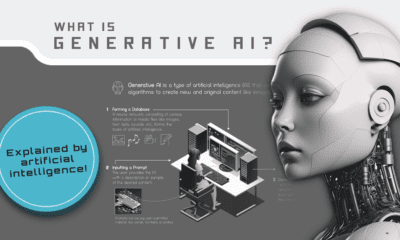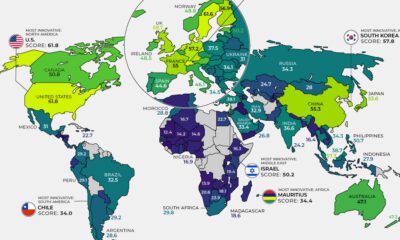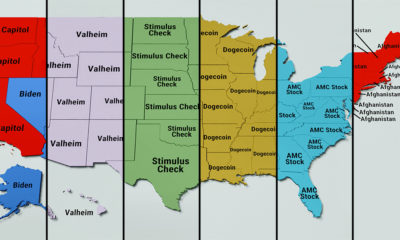However, in the case of science fiction, the human imagination has gotten a few things right—especially when it comes to futuristic forecasts. Today, the artificial intelligence (AI) revolution is transforming everything, but it turns out we had a hunch about it all along.
When AI Comes to Life
Today’s infographic from Noodle.ai takes a look at how some movie and television predictions for AI’s capabilities have taken hold in the real world.
Many early “predictions” about future technologies certainly missed the mark—but it seems science fiction was able to accurately forecast a thing or two about AI.
AI Basics: Making Life Better
Artificial intelligence is all about equipping machines with the ability to mimic human decision-making processes. It has a wide range of applications, from basic automation to advanced machine learning models. AI has proliferated into virtually every aspect of life, and in the graphic, it’s clear that several sci-fi-turned-real inventions are aimed at making things more convenient for us humans. Of course, these have had varying degrees of success. While Google Glass didn’t initially resonate with the wider public, the augmented reality smart glasses have now proved useful in businesses such as manufacturing. Elsewhere, sci-fi-inspired advances in industries like healthtech are providing a new lease of life for many patients—and continuously reinventing the frontier of what we think is possible.
Sci-Fi Helps Us Push Boundaries
One monumental event in AI history occurred in 1997, when IBM’s Deep Blue beat a chess master at his own game. This event shook the world when we realized what AI could truly be capable of—even though sci-fi had in fact anticipated it 20 years prior. But as the graphic shows, not all is rosy in science fiction’s likeness of AI. It’s often depicted as something to fear, and certain predictions have proved to be eerily accurate. While not all of these are causes for alarm, they clearly demonstrate that sci-fi has the capacity to influence the breakthrough technology we could end up seeing a few years down the line. However, turning reel to real can raise some curious dilemmas.
Rights for Robots?
Last year, the European Parliament debated an interesting question: do robots qualify as people? The resolution considered granting “personhood” to sophisticated, autonomous robots. However, over 150 AI experts strongly warned against this proposal, arguing it would “blur the relation between man and machine” in a way that is too unethical. Nevertheless, this thought experiment proves that artificial intelligence is matching our wildest imagined predictions for it. —Tesler’s Theorem As we move ever closer towards a world where AI is inextricably linked with the everyday, how else could science fiction shape our expectations of the future? on But fast forward to the end of last week, and SVB was shuttered by regulators after a panic-induced bank run. So, how exactly did this happen? We dig in below.
Road to a Bank Run
SVB and its customers generally thrived during the low interest rate era, but as rates rose, SVB found itself more exposed to risk than a typical bank. Even so, at the end of 2022, the bank’s balance sheet showed no cause for alarm.
As well, the bank was viewed positively in a number of places. Most Wall Street analyst ratings were overwhelmingly positive on the bank’s stock, and Forbes had just added the bank to its Financial All-Stars list. Outward signs of trouble emerged on Wednesday, March 8th, when SVB surprised investors with news that the bank needed to raise more than $2 billion to shore up its balance sheet. The reaction from prominent venture capitalists was not positive, with Coatue Management, Union Square Ventures, and Peter Thiel’s Founders Fund moving to limit exposure to the 40-year-old bank. The influence of these firms is believed to have added fuel to the fire, and a bank run ensued. Also influencing decision making was the fact that SVB had the highest percentage of uninsured domestic deposits of all big banks. These totaled nearly $152 billion, or about 97% of all deposits. By the end of the day, customers had tried to withdraw $42 billion in deposits.
What Triggered the SVB Collapse?
While the collapse of SVB took place over the course of 44 hours, its roots trace back to the early pandemic years. In 2021, U.S. venture capital-backed companies raised a record $330 billion—double the amount seen in 2020. At the time, interest rates were at rock-bottom levels to help buoy the economy. Matt Levine sums up the situation well: “When interest rates are low everywhere, a dollar in 20 years is about as good as a dollar today, so a startup whose business model is “we will lose money for a decade building artificial intelligence, and then rake in lots of money in the far future” sounds pretty good. When interest rates are higher, a dollar today is better than a dollar tomorrow, so investors want cash flows. When interest rates were low for a long time, and suddenly become high, all the money that was rushing to your customers is suddenly cut off.” Source: Pitchbook Why is this important? During this time, SVB received billions of dollars from these venture-backed clients. In one year alone, their deposits increased 100%. They took these funds and invested them in longer-term bonds. As a result, this created a dangerous trap as the company expected rates would remain low. During this time, SVB invested in bonds at the top of the market. As interest rates rose higher and bond prices declined, SVB started taking major losses on their long-term bond holdings.
Losses Fueling a Liquidity Crunch
When SVB reported its fourth quarter results in early 2023, Moody’s Investor Service, a credit rating agency took notice. In early March, it said that SVB was at high risk for a downgrade due to its significant unrealized losses. In response, SVB looked to sell $2 billion of its investments at a loss to help boost liquidity for its struggling balance sheet. Soon, more hedge funds and venture investors realized SVB could be on thin ice. Depositors withdrew funds in droves, spurring a liquidity squeeze and prompting California regulators and the FDIC to step in and shut down the bank.
What Happens Now?
While much of SVB’s activity was focused on the tech sector, the bank’s shocking collapse has rattled a financial sector that is already on edge.
The four biggest U.S. banks lost a combined $52 billion the day before the SVB collapse. On Friday, other banking stocks saw double-digit drops, including Signature Bank (-23%), First Republic (-15%), and Silvergate Capital (-11%).
Source: Morningstar Direct. *Represents March 9 data, trading halted on March 10.
When the dust settles, it’s hard to predict the ripple effects that will emerge from this dramatic event. For investors, the Secretary of the Treasury Janet Yellen announced confidence in the banking system remaining resilient, noting that regulators have the proper tools in response to the issue.
But others have seen trouble brewing as far back as 2020 (or earlier) when commercial banking assets were skyrocketing and banks were buying bonds when rates were low.














